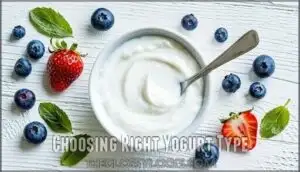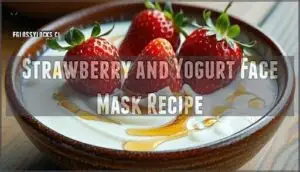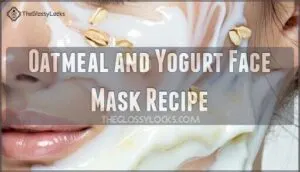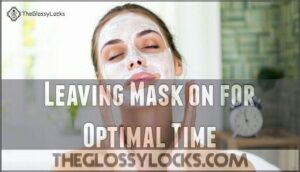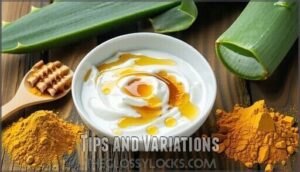This site is supported by our readers. We may earn a commission, at no cost to you, if you purchase through links.
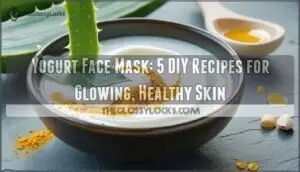
You’ll mix plain yogurt with ingredients like honey, turmeric, or aloe vera to target specific skin concerns.
The lactic acid in yogurt naturally exfoliates dead skin cells while probiotics fight acne-causing bacteria.
For oily skin, try combining half a cup of yogurt with a teaspoon of honey and half a teaspoon of turmeric.
If you’re dealing with irritation, blend quarter cup yogurt with a tablespoon each of honey and aloe vera gel.
Apply the mixture, leave it for fifteen minutes, then rinse with warm water.
The right combination can transform your complexion overnight with the help of probiotics.
Table Of Contents
- Key Takeaways
- Yogurt Face Mask Benefits
- Choosing Right Yogurt Type
- Yogurt Face Mask Recipes
- Applying Yogurt Face Mask
- Tips and Variations
- Frequently Asked Questions (FAQs)
- Is yogurt mask good for the face?
- What does yogurt do to your face?
- How long should I leave yogurt on my face?
- How to make a yogurt face mask?
- How long should you leave yogurt on your face?
- How do you make a yogurt face mask?
- What can I mix with yogurt for my face?
- Can yogurt face masks cause allergic reactions?
- How long does a homemade yogurt mask last?
- Is Greek yogurt better for face masks?
- Conclusion
Key Takeaways
- You’ll get powerful skin benefits from yogurt’s lactic acid and probiotics – they naturally exfoliate dead cells, fight acne-causing bacteria, reduce inflammation, and boost moisture retention for healthier-looking skin.
- Choose plain, unflavored yogurt for best results – avoid sweetened or flavored varieties that can clog pores and cause irritation, with Greek yogurt being ideal due to its thick consistency that won’t drip off your face.
- You can customize masks for your specific skin needs – add honey and turmeric for acne-prone skin, avocado for dry skin, or aloe vera for sensitive skin to target your particular concerns.
- Apply correctly for maximum effectiveness – cleanse your face first, use circular motions when applying, leave the mask on for 15-20 minutes, then rinse with lukewarm water and follow with moisturizer.
Yogurt Face Mask Benefits
Yogurt face masks offer multiple skin benefits through their unique combination of lactic acid, probiotics, and essential vitamins that work together to improve your skin’s health and appearance.
You’ll experience enhanced moisture retention, reduced acne-causing bacteria, gentle exfoliation, and decreased inflammation when you apply yogurt-based treatments to your face regularly, which can lead to improved skin health and decreased inflammation.
Moisturizes and Nourishes Skin
Your skin craves hydration like a thirsty plant needs water.
Yogurt face masks deliver deep moisturizing through lactic acid, which boosts skin hydration and locks in moisture.
The calcium benefits help restore your skin’s natural barrier, while fatty acids nourish from within.
This vitamin absorption process improves skin elasticity, leaving you with supple, well-nourished skin that glows naturally.
Fights Acne-Causing Bacteria
Breakouts don’t stand a chance against yogurt’s bacterial-fighting arsenal. Your yogurt face mask delivers powerful probiotics that restore your skin’s bacterial balance, while zinc eliminates acne-causing germs before they wreak havoc.
Transform your skin with yogurt’s probiotic power—nature’s answer to stubborn breakouts and bacterial imbalance.
Here’s how yogurt tackles acne:
- Probiotics destroy harmful bacteria naturally
- Zinc reduces inflammation and blemishes
- Lactic acid prevents infection-causing buildup
- Honey’s antibacterial properties boost acne treatment effectiveness
Natural Anti-Aging Properties
Time’s march shows on your face, but yogurt face masks pack powerful antiaging ammunition.
Lactic acid naturally exfoliates dead cells while boosting skin elasticity and smoothing fine lines.
The vitamin benefits include B12 for evening tone and zinc that fights free radicals causing premature aging.
Regular hydration effects from yogurt’s nutrients help minimize wrinkles, keeping your complexion looking younger longer.
Hydrates and Exfoliates Skin
Your skin gets a double boost from yogurt’s lactic acid content, which naturally exfoliates dead cells while locking in moisture.
This gentle alpha-hydroxy acid improves skin elasticity and promotes healthy cell turnover.
The calcium effects enhance moisture retention, while probiotic benefits support your skin’s natural barrier.
A yogurt face mask delivers targeted skin hydration techniques for smoother, more radiant results, utilizing the power of lactic acid.
Soothes Irritated Skin and Reduces Inflammation
When your skin feels like it’s throwing a tantrum, yogurt’s cooling effects work like a gentle hug for irritated areas.
The natural antiinflammatory properties in this soothing mask provide immediate redness relief, while probiotics calm sensitive skin reactions.
Your yogurt face mask delivers targeted inflammation reduction, transforming angry, red patches into comfortable, balanced skin that feels refreshed and restored.
For enhanced calming, consider a serum with ingredients to strengthen the skin barrier.
Choosing Right Yogurt Type
You’ll need to select the correct yogurt type to maximize your face mask’s effectiveness and prevent skin irritation.
Plain, unflavored yogurt works best because it contains beneficial lactic acid and probiotics without added sugars or artificial ingredients that can clog pores or cause breakouts.
Plain Unflavored Yogurt Recommendations
Plain yogurt serves as your skincare foundation, delivering probiotics and lactic acid without unnecessary additives.
Choose organic yogurt when possible to minimize potential skin irritants from conventional dairy processing.
- Cows milk yogurt provides the highest calcium content for ideal skin healing
- Goats milk offers a gentler alternative for those with dairy sensitivities
- Plant-based options work well for vegan skincare routines, though they lack traditional dairy benefits
Consider various brands available for your yogurt mask.
Greek and Icelandic Style Yogurt Benefits
Texture advantages make Greek and Icelandic yogurts your skin’s best friends. Whey reduction creates thicker mask consistency, ensuring application ease without dripping down your face.
This richness comparison shows these varieties pack more probiotics and lactic acid per spoonful, delivering enhanced skin benefits. Your Greek yogurt face mask won’t slide off mid-treatment.
| Feature | Greek/Icelandic Yogurt |
|---|---|
| Texture | Thick, creamy consistency |
| Whey Content | Reduced through straining |
| Application | Stays in place easily |
| Nutrient Density | Higher concentration per serving |
Plant Based Yogurt Alternatives
If you’re dealing with dairy allergy or dairy sensitivity, plant-based yogurts offer excellent alternatives for your DIY recipes.
Almond yogurt, coconut yogurt, soy yogurt, and oat yogurt all provide similar probiotic skincare benefits as traditional varieties.
These plant-based yogurt options maintain the creamy consistency needed for effective face masks while delivering the same moisturizing and anti-inflammatory properties for healthy skin.
For instance, you can even make your own using a vegan probiotic starter.
Avoiding Flavored and Sweetened Yogurt
Skip the strawberry vanilla and other flavored varieties when making your yogurt face mask.
Artificial additives and sugar content can trigger skin irritation and reduce mask effectiveness. These sweeteners feed harmful bacteria, counteracting probiotics that benefit your complexion.
Choose plain yogurt or Greek yogurt instead—these natural alternatives deliver maximum dairybased skincare benefits without compromising your skin’s health, leveraging the power of natural ingredients.
Yogurt Face Mask Recipes
You can create effective yogurt face masks by combining plain yogurt with natural ingredients like strawberries, avocado, or oatmeal to address specific skin concerns.
These simple recipes allow you to customize treatments based on your skin type, whether you need brightening, moisturizing, or gentle exfoliation, and they enable you to create a personalized skincare routine with natural ingredients.
Strawberry and Yogurt Face Mask Recipe
Three ripe strawberries combined with one teaspoon plain yogurt and honey create this brightening DIY face mask.
Mash strawberries thoroughly, blend with yogurt, then apply to cleansed skin for fifteen minutes.
This facial mask recipe offers strawberry benefits like natural exfoliation and vitamin C.
Many users enjoy the strawberry yogurt mask for its soothing properties.
Use twice weekly for sensitive skin, adjusting recipe variations based on strawberry sourcing and mask frequency preferences, to achieve the best DIY face mask results.
Avocado and Yogurt Face Mask Recipe
Looking for deeper skin hydration? This avocado mask delivers serious moisture.
Mix ¼ mashed avocado with one teaspoon plain yogurt and one teaspoon olive oil. The creamy mask consistency makes application easy—spread on face, neck, and décolleté.
Leave for fifteen minutes, then rinse with lukewarm water. This DIY face mask combines avocado benefits with yogurt’s probiotics for ultimate nourishment.
Oatmeal and Yogurt Face Mask Recipe
Oatmeal and yogurt create the perfect partnership for gentle skin renewal.
Mix one teaspoon each of plain yogurt, finely ground oatmeal, and honey to form a thick paste.
This homemade mask combines oatmeal’s exfoliating properties with yogurt’s moisturizing benefits.
Apply the mixture evenly, let it work for fifteen minutes, then rinse with lukewarm water for softer, smoother skin.
You can also use this mask to deep clean pores and remove dead skin cells, which is a great way to achieve softer, smoother skin.
Customizing Recipes for Skin Types
Your skin type determines which yogurt face mask recipe works best for you.
For oily skin or acne-prone complexions, add bentonite clay or activated charcoal to your DIY recipes. Dry skin benefits from honey and avocado additions, while sensitive skin responds well to chamomile or aloe vera.
Combination skin requires targeting different facial zones with customized yogurt face mask formulations.
Yogurt contains alpha hydroxy acids, which can help exfoliate and brighten the skin, making it a great ingredient for yogurt face masks that promote healthy and glowing skin.
Applying Yogurt Face Mask
Proper application technique guarantees you’ll get maximum benefits from your yogurt face mask while avoiding common mistakes that can reduce effectiveness.
You’ll need to prepare your skin correctly, apply the mask evenly using circular motions, time the treatment appropriately, and follow proper removal procedures to achieve superior results.
Preparing Skin for Mask Application
Before you slather on that yogurt goodness, proper facial cleansing sets the stage for maximum benefits.
Start with lukewarm water to open pores, then cleanse thoroughly using gentle circular motions.
Pat dry with a clean towel—no harsh rubbing.
If you’re trying a new recipe, patch testing on your wrist prevents unwanted surprises.
Skip exfoliating beforehand; yogurt’s lactic acid handles that job perfectly.
Applying Mask in Circular Motions
Gentle pressure works wonders when applying your yogurt face mask.
Use your fingertips to massage the mixture across your face in small circular motions, promoting circulation boost and ensuring even distribution.
This facial massage technique provides gentle exfoliation while enhancing product absorption into your skin.
The massage benefits include improved blood flow, helping your skin better absorb the beauty benefits of your homemade treatment, which can lead to improved overall skin health through gentle exfoliation.
Leaving Mask on for Optimal Time
After you’ve smoothly applied your yogurt face mask, timing becomes your next priority.
Leave the facial treatment on for 15-20 minutes to maximize skin benefits. This ideal timing allows the plain yogurt’s lactic acid and probiotics to work effectively without over-drying.
Watch for skin sensitivity signs and adjust mask duration accordingly. Your DIY skincare routine depends on proper application frequency for best results.
Rinsing and Moisturizing After Mask
After your yogurt face mask has worked its magic, rinse thoroughly with lukewarm water temperature to remove all residue.
Follow with cool water to close pores, then focus on patting dry with a clean towel—never rub harshly.
Complete your routine by applying a gentle moisturizer choice suited to your skin sensitivity, ensuring ideal facial hydration and skin moisture retention, for optimal facial hydration.
Tips and Variations
You can customize your yogurt face mask by adding specific ingredients that target your skin’s unique needs and concerns.
Simple additions like honey for moisture, turmeric for inflammation, or aloe vera for sensitive skin will enhance the mask’s effectiveness and help you achieve better results.
Using Honey and Turmeric for Enhanced Benefits
Combining honey’s antibacterial properties with turmeric’s anti-inflammatory effects creates a powerhouse yogurt face mask for skin brightening.
Mix one tablespoon plain yogurt, one teaspoon raw honey, and half teaspoon turmeric powder. This turmeric face mask variation addresses multiple skin sensitivity concerns while delivering enhanced benefits.
You can find a honey yogurt mask for purchase online.
Patch test first, as turmeric may temporarily stain lighter skin tones yellow, which is an important consideration for skin brightening and using turmeric face mask with honey yogurt mask.
Adding Aloe Vera for Soothing Effects
Aloe vera benefits your yogurt face mask by delivering instant relief to angry, red skin.
This powerhouse ingredient transforms your basic recipe into a soothing mask that tackles irritation reduction head-on.
- Mix equal parts yogurt and fresh aloe gel for maximum redness reduction
- Apply using gentle patting motions instead of rubbing to avoid further skin irritation
- Leave on for 20 minutes to let combining ingredients work their magic
Mixing With Green Tea for Antioxidant Boost
Nobody’s arguing that green tea benefits your skin like a superhero in a cup.
Brew strong green tea, let it cool completely, then replace water in your yogurt face mask recipe with this antioxidant-packed liquid.
This DIY face mask preparation technique delivers natural skincare that fights free radicals while maintaining proper application techniques for all skin types, providing a great way to utilize green tea.
Storing and Reusing Yogurt Face Masks
While fresh is always best, you can store leftover yogurt masks properly to maximize their shelf-life and maintain probiotics that fight skin infections.
Here’s your storage game plan:
- Storage Containers: Use sealed glass jars in the fridge for 5-7 days
- Batch Preparation: Make 2-3 portions at once for convenience
- Refrigeration Effects: Cold storage preserves beneficial ingredients longer
- Reuse Safety: Always do a patch test before reapplying stored masks
- Mask Shelf-life: Discard if texture changes dramatically or develops odors.
To prevent bacterial growth, consider using natural preservatives in larger batches.
Frequently Asked Questions (FAQs)
Is yogurt mask good for the face?
Research backs yogurt’s skin benefits through lactic acid and probiotics.
You’ll get gentle exfoliation, deep hydration, and reduced inflammation.
It’s particularly effective for brightening dull skin and fighting acne-causing bacteria naturally, providing deep hydration.
What does yogurt do to your face?
Yogurt delivers lactic acid that gently exfoliates dead skin cells while probiotics restore your skin’s natural balance.
You’ll notice brighter, smoother skin as calcium hydrates and zinc reduces inflammation, giving you that healthy glow.
How long should I leave yogurt on my face?
Like a gentle timer counting down to refreshed skin, you’ll want to leave your yogurt mask on for 15-20 minutes.
This gives the lactic acid time to work its magic without overdrying your complexion.
How to make a yogurt face mask?
Mix two tablespoons plain Greek yogurt with one teaspoon raw honey.
Add optional ingredients like turmeric or avocado based on your skin’s needs.
Apply evenly, wait twenty minutes, then rinse with cool water, using cool water to finish the process.
How long should you leave yogurt on your face?
Think of your skin like a sponge soaking up nutrients—you’ll want to leave that yogurt mask on your face for about 15-20 minutes.
Giving it enough time to work its magic without overdrying.
How do you make a yogurt face mask?
Creating your own skincare treatment is surprisingly simple.
Combine two tablespoons of plain Greek yogurt with one teaspoon of raw honey.
Apply this mixture to clean skin, let it sit for twenty minutes, then rinse off.
What can I mix with yogurt for my face?
Your kitchen’s like a treasure chest of skin-loving ingredients.
You can blend honey for moisture, turmeric for brightening, avocado for hydration, oatmeal for gentle exfoliation, or lemon juice to tackle dark spots naturally.
This blend of ingredients offers various benefits, including hydration from avocado.
Can yogurt face masks cause allergic reactions?
Yes, you can experience allergic reactions from yogurt face masks, especially if you’re lactose intolerant or have dairy allergies.
Always patch test on your wrist 24 hours before applying to avoid irritation.
How long does a homemade yogurt mask last?
Fresh homemade yogurt masks last only 2-3 days when you store them in your refrigerator.
Don’t risk bacterial growth – it’s safer to whip up a new batch each time you’re ready for skincare.
Is Greek yogurt better for face masks?
Greek yogurt’s thicker consistency makes it ideal for face masks since it won’t drip off your skin.
You’ll get better coverage and easier application compared to regular yogurt, plus concentrated probiotics for enhanced benefits.
Conclusion
Like Cleopatra’s legendary beauty rituals, your yogurt face mask journey transforms simple kitchen ingredients into powerful skincare solutions.
You’ve discovered how yogurt’s natural acids and probiotics work together to reveal healthier, more radiant skin.
Whether you’re targeting acne, dryness, or signs of aging, these DIY recipes offer affordable alternatives to expensive treatments.
Remember to patch test new combinations and choose plain, unflavored yogurt for best results, using this gentle and effective approach to natural skincare, and your skin will thank you.

